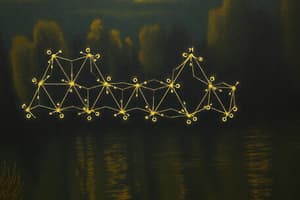Podcast
Questions and Answers
What are valence electrons?
What are valence electrons?
An electron in the highest occupied energy level of an atom.
For the representative elements, how do you easily determine the number of valence electrons?
For the representative elements, how do you easily determine the number of valence electrons?
By looking at the last number of their group number.
What is an electron dot structure?
What is an electron dot structure?
The number of valence electrons represented as dots put around the chemical symbol of an element.
What is the electron dot structure for Barium (Ba)?
What is the electron dot structure for Barium (Ba)?
Write the electron dot structure for Tellurium (Te).
Write the electron dot structure for Tellurium (Te).
What is an octet?
What is an octet?
What is the Octet Rule?
What is the Octet Rule?
What happens to an atom when a cation is formed?
What happens to an atom when a cation is formed?
What happens to an atom when an anion is formed?
What happens to an atom when an anion is formed?
Write Potassium (K) electron configuration.
Write Potassium (K) electron configuration.
How many valence electrons does Potassium (K) have?
How many valence electrons does Potassium (K) have?
Write Potassium (K) ion electron configuration.
Write Potassium (K) ion electron configuration.
Write the electron configuration for Phosphorus (P).
Write the electron configuration for Phosphorus (P).
How many valence electrons does Phosphorus (P) have?
How many valence electrons does Phosphorus (P) have?
Write the ion electron configuration for Phosphorus (P).
Write the ion electron configuration for Phosphorus (P).
Write the electron configuration for Fluorine (F).
Write the electron configuration for Fluorine (F).
How many valence electrons does Fluorine (F) have?
How many valence electrons does Fluorine (F) have?
Write the ion electron configuration for Fluorine (F).
Write the ion electron configuration for Fluorine (F).
Write the electron configuration for Magnesium (Mg).
Write the electron configuration for Magnesium (Mg).
How many valence electrons does Magnesium (Mg) have?
How many valence electrons does Magnesium (Mg) have?
Write the ion electron configuration for Magnesium (Mg).
Write the ion electron configuration for Magnesium (Mg).
What is a halide?
What is a halide?
What is the ion charge of all halides?
What is the ion charge of all halides?
Write the ion formula of a Sodium ion.
Write the ion formula of a Sodium ion.
Write the ion formula of Iodide.
Write the ion formula of Iodide.
Write the ion formula of Oxide.
Write the ion formula of Oxide.
Write the ion formula of a Magnesium ion.
Write the ion formula of a Magnesium ion.
What is an ionic bond?
What is an ionic bond?
What is an ionic compound?
What is an ionic compound?
The overall charge of an ionic compound is neutral.
The overall charge of an ionic compound is neutral.
What is a chemical formula?
What is a chemical formula?
What is a formula unit?
What is a formula unit?
List 3 properties of ionic compounds.
List 3 properties of ionic compounds.
What are metallic bonds?
What are metallic bonds?
How do metallic bonds help metals conduct electricity?
How do metallic bonds help metals conduct electricity?
What is an alloy?
What is an alloy?
Why have alloys?
Why have alloys?
What alloy did you make when you turned the penny gold-colored?
What alloy did you make when you turned the penny gold-colored?
What elements did you mix when you turned the penny gold-colored?
What elements did you mix when you turned the penny gold-colored?
Flashcards are hidden until you start studying
Study Notes
Valence Electrons
- Valence electrons are the highest occupied energy level electrons in an atom.
- For representative elements, the number of valence electrons can be determined by the last digit of their group number.
Electron Dot Structure
- An electron dot structure represents the number of valence electrons as dots around an element's chemical symbol.
- Example: Barium (Ba) has 2 dots; Tellurium (Te) has 6 dots.
Octet Rule
- An octet consists of 8 electrons.
- The Octet Rule states that atoms strive to achieve 8 valence electrons, similar to the nearest noble gas, by gaining, losing, or sharing electrons.
Ionic Charge Formation
- Cations are formed when an atom loses one or more electrons.
- Anions are formed when an atom gains one or more electrons.
Electron Configuration
- Potassium (K) electron configuration: [Ar] 4s1, has 1 valence electron.
- Potassium ion configuration: [Ne] 3s2 3p6.
- Phosphorus (P) electron configuration: [Ne] 3s2 3p3, has 5 valence electrons.
- Fluorine (F) electron configuration: [He] 2s2 2p5, has 7 valence electrons.
- Magnesium (Mg) electron configuration: [Ne] 3s2, has 2 valence electrons.
Ion Formulas
- Sodium ion: Na +
- Iodide: I -
- Oxide: O 2-
- Magnesium ion: Mg 2+
Ionic Bonds and Compounds
- An ionic bond is formed when oppositely charged ions attract and bond as electrons are transferred.
- Ionic compounds consist of cations and anions and are electrically neutral overall.
- A chemical formula indicates the number of atoms of each element in the smallest representative unit of a substance.
- A formula unit is the smallest whole-number ratio of ions in an ionic compound.
Properties of Ionic Compounds
- Ionic compounds are solid at room temperature, have a hard and brittle crystal structure, and can conduct electricity when dissolved.
Metallic Bonds and Alloys
- Metallic bonds involve attractions between free-floating valence electrons and positively charged metal ions.
- Metalllic bonds facilitate electricity conduction as metal cations can slide past one another under pressure.
- An alloy is a mixture of two or more elements, where at least one component is a metal, resulting in superior properties compared to the individual elements.
- Brass, made from copper and zinc, is an example of an alloy produced by turning a penny gold-colored.
Studying That Suits You
Use AI to generate personalized quizzes and flashcards to suit your learning preferences.




